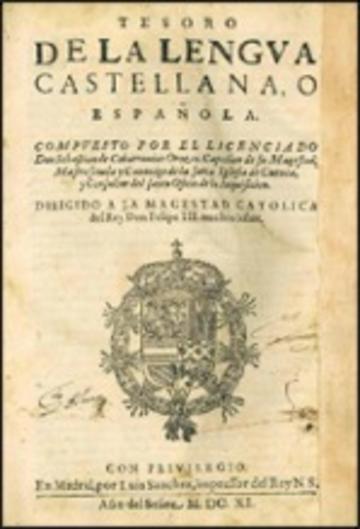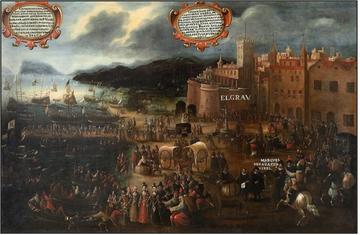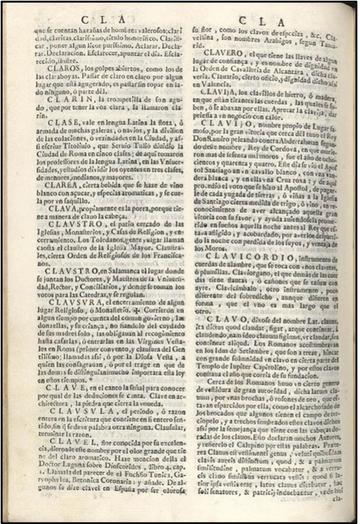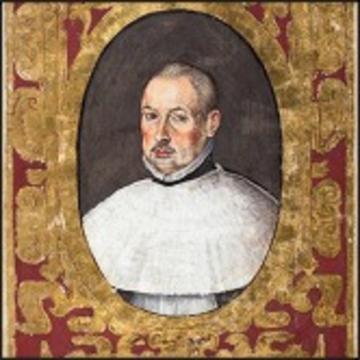The definition of an (auto)biography: Professor Jacques Lezra and Sebastián de Covarrubias
In Hispanic studies, the surname Covarrubias has made it to the very select group of family names more commonly used to designate its bearer’s creation than the bearer himself. The Tesoro de Covarrubias’ renown has indeed exceeded that of its author, Sebastián de Covarrubias. This work — a unique compendium of definitions, originally titled Tesoro de la lengua castellana o española and published in 1611, much earlier than modern dictionaries — has become the cornerstone of Spanish lexicography, being for many decades now an essential tool for any researcher in the field of early modern Castilian literature. So has the metonymy become too robust or is it still possible to dissociate its components? Can we look at Covarrubias beyond his work and ask ourselves who Covarrubias the person was? Such were the core questions explored by Professor Jacques Lezra in two CEMS masterclasses on 21 and 23 February 2024.

Front page of the Tesoro.
The first session was devoted to drawing a series of parallelisms between the author and his work, stressing the notion of failure that revolves around both of them. By placing the Tesoro as an integral part of Sebastián de Covarrubias’ effort in evangelising Valencian Moriscos — something which was never accomplished, since they would be expelled from the Iberian Peninsula in 1609 —, Professor Lezra presented the lexicographical project in political terms, as a linguistical foundation for the conversions to be successful. This connection could explain the Tesoro’s detailed definitions running out of steam midway through the alphabet, just as the evangelisation project ran out of steam as well. Furthermore, the speaker also sustained this thesis by the fact that the supplement Covarrubias wrote after the failure of the evangelisation attempts is much more concise, more hegemonic and nationalistic in its identitarian definitions. Professor Lezra exemplified this transition by contrasting the entries for the word Judío (“Jew”). In the Tesoro, this involves a fairly brief and bland recitation of what were perceived as historical facts about Jews; in the Suplemento, this becomes not just a set of antisemitic tropes but a tissue of expanding narratives in which these tropes are embodied. The Suplemento can thus be thought of as a project of state consolidation that was largely obscured in the Tesoro, when the author still considered that documenting linguistic usage in the course of the sixteenth century would be crucial in supporting the conversion of the Moriscos.

Embarque de los moriscos en el Grao de Valencia, by Pedro Oromig (1613).
These connections between Covarrubias’ personal life project and his work, both in terms of its extension and the nature of its definitions, raised a debate in the Mure Room concerning the influence of the first person in one’s writing, which was linked to the contemporary problems of impersonality and cultural definition. Professor Lezra summarised the discussion with a brilliant and conceptually challenging question: ‘What constitutes the oneness of a life?’. Certainly, the idea of oneness itself appears to be problematic all throughout Covarrubias’ Tesoro. When Lezra approaches the work as a ‘strange, new genre of writing’, as a ‘first-person dictionary’, what he finds is a blockage of the notion of definitive being and being definitive. By filling his definitions with verbs of perception (yo entiendo, yo creo) and with narrative excerpts, Sebastián de Covarrubias conveys a sense of doubtfulness in the oneness of things in the same way in which Professor Lezra reflects upon the act of writing’s ineludible subjectivity.

A page in Covarrubias’ Tesoro.
The second session began by exploring biographical methodologies. Since Hispanism comes from a long tradition of positivistic biographies based on exhaustively digging into archives and legal documents, Professor Lezra has wanted to experiment with what the limits of such kind of research are. Can the legal shadow drawn by dozens of documents accurately represent a life? Is that enough to grasp a sense of what one’s life has been? These are questions that appeal to our own ontological anxieties, and which Lezra confronted with what he described as the impossibility of disentangling the biographer’s object of study from the biographer’s subjectivity. These points were followed by a second half of fascinating debate. After discussing the opposing models of visibilisation and invisibilisation of the author, Professor Lezra argued that making himself visible as a biographer does not feel enough, especially when working with a text such as the Tesoro, in which there is a significant amount of storytelling and ambiguity that cannot be explained by the mere recollection of legal documents. His thesis is that biographing Sebastián de Covarrubias requires some sort of confession, which he deals with by letting certain aspects of his own life become part of Covarrubias’ story. As a member of the audience suggested, what Jacques Lezra has succeeded in doing is filling the voids in the life and work of Sebastián de Covarrubias, and more specifically the gap between the Tesoro and the subsequent Suplemento, with his own personal background, which implies leaving positivism far behind.

Portrait of Sebastián de Covarrubias.
These masterclasses rounded off with a discussion of the Tesoro’s use as a philological tool for Hispanists. By paying attention to its author, his subjectivity and the investment he had in the politics of conversion of the Spanish monarchy, Jacques Lezra has put a question mark on the objectivity with which Covarrubias’ definitions have previously been regarded. Therefore, Professor Lezra’s contribution may change the conception of a work many people have used but very few have ever considered on its own.
Report by Rubén Bracero Salvat.



